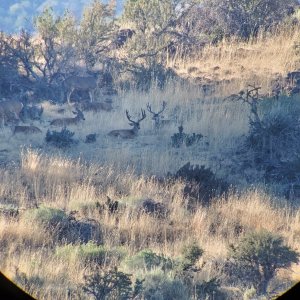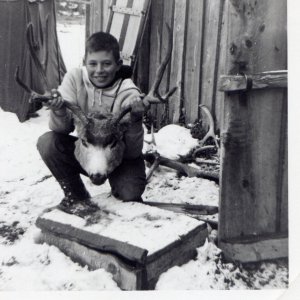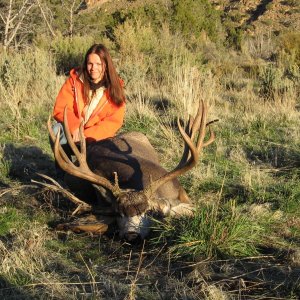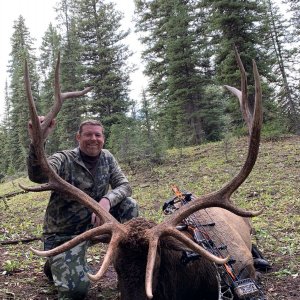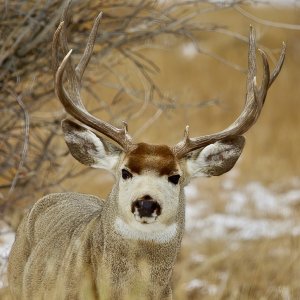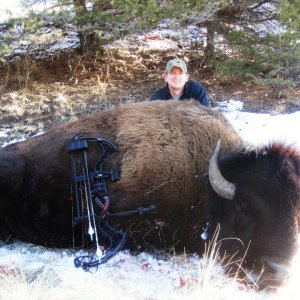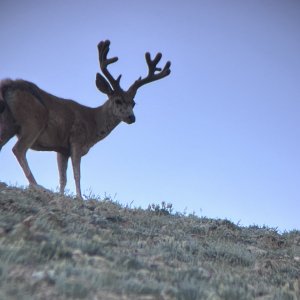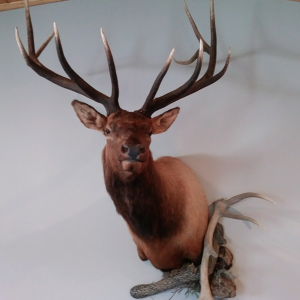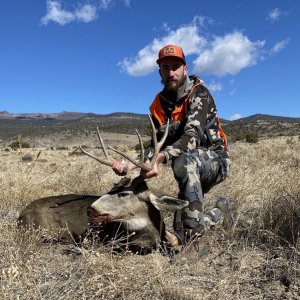NVBighorn
Long Time Member
- Messages
- 9,458
As a follow-up to Ryan?s (aka nvnative79) post on the Utah sheep status thread I thought I'd post some pictures that he and I took.
First of all I'd like to say that it was a lot of fun and I hope to do it again sometime. It was also fun to carpool with Ryan and talk hunting and get to know him better.
Cooperative, collaborative projects like these are why bighorns have been restored to so much of their historic range. It is also the reason we have so many opportunities to hunt sheep. Groups like FNAWS, GSCO, Nevada Bighorns Unlimited, Fraternity of the Desert Bighorn (to name just a few) as well as many others play such an important role in this effort.
The first picture is the contract helicopter and fuel truck waiting for us to get organized. The guys that fly in that thing are absolutely insane, I swear. Talk about adrenaline junkies. Imagine skimming along in the rocks just a few feet off the ground, shooting a net gun to cast a net over a running sheep. Then the mugger jumps out, hobbles and blind folds the sheep, packs it to where the helo can land and hefts it in the backseat. All this while trying to keep the animals as calm as possible.

In this picture we are getting our safety briefing. Ryan and I got to help unload and pack the sheep to the area where they were processed.

The third picture (kudos to Ryan for a great shot) is when they were ferrying two sheep in from the rocky area just to the right of the helicopter. Normally they loaded the sheep in the back seat but this load was in such rough country they decided to suspend them.

Here the sheep are being processed. The tarp we worked on was more like a triage center in an emergency room. Body temperature was monitored and the sheep cooled with water if necessary. They also received a couple of antibiotic injections, had nasal, blood and fecal samples taken, had an ear tag put in and some of them were fitted with a radio telemetry collars. Everything was done with as little stress as possible and as quietly as possible. By the end of the day the group was very efficient at their jobs. I was amazed at how well a group of volunteers, most of whom had never seen each other before or done this before, along with the professionals worked together.








Here the sheep is done being processed and being taken to the trailer to await the trip to Utah.

First of all I'd like to say that it was a lot of fun and I hope to do it again sometime. It was also fun to carpool with Ryan and talk hunting and get to know him better.
Cooperative, collaborative projects like these are why bighorns have been restored to so much of their historic range. It is also the reason we have so many opportunities to hunt sheep. Groups like FNAWS, GSCO, Nevada Bighorns Unlimited, Fraternity of the Desert Bighorn (to name just a few) as well as many others play such an important role in this effort.
The first picture is the contract helicopter and fuel truck waiting for us to get organized. The guys that fly in that thing are absolutely insane, I swear. Talk about adrenaline junkies. Imagine skimming along in the rocks just a few feet off the ground, shooting a net gun to cast a net over a running sheep. Then the mugger jumps out, hobbles and blind folds the sheep, packs it to where the helo can land and hefts it in the backseat. All this while trying to keep the animals as calm as possible.

In this picture we are getting our safety briefing. Ryan and I got to help unload and pack the sheep to the area where they were processed.

The third picture (kudos to Ryan for a great shot) is when they were ferrying two sheep in from the rocky area just to the right of the helicopter. Normally they loaded the sheep in the back seat but this load was in such rough country they decided to suspend them.

Here the sheep are being processed. The tarp we worked on was more like a triage center in an emergency room. Body temperature was monitored and the sheep cooled with water if necessary. They also received a couple of antibiotic injections, had nasal, blood and fecal samples taken, had an ear tag put in and some of them were fitted with a radio telemetry collars. Everything was done with as little stress as possible and as quietly as possible. By the end of the day the group was very efficient at their jobs. I was amazed at how well a group of volunteers, most of whom had never seen each other before or done this before, along with the professionals worked together.








Here the sheep is done being processed and being taken to the trailer to await the trip to Utah.


